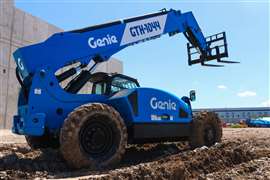Demolition: Heavy metal at work
10 May 2013
.gif)
If you ask a member of the public what demolition is, the odds are short that you will get one of two answers – spectacular explosive demolitions or a swinging wrecking ball. However, some may now identify a third in the shape of high reach demolition excavators chewing on a building, especially those that have been exposed to modern urban demolition.
But in recent years, few new models of this machine type have appeared on the market. The reasons for this are complex, but for certain one of these is market conditions – times are equally tough for demolition contractors around the world as it is for their construction partners, with many major projects on hold or even cancelled and therefore the need to clear sites for the new build is also delayed or cancelled.
But there is another more practical reason for the major manufacturers to be reluctant to introduce new machines. First, they are hardly volume products – estimates of the market size for these machines vary and indeed are little more than best guesses, but for machines under 40 m it is likely that no more than 400-500 are produced annually around the world, while for the +40 m monsters, it is likely that the corresponding number is in the 10s not 100s.
The pages of iC over recent months, and indeed over recent years, have been filled with the descriptions of new products developed because of the ongoing drive to clean up diesel engines and make them more environmentally friendly. This involves considerable R&D effort on the part of the manufacturers, as attested by the number of new standard construction equipment that meet the latest, Tier 4 Interim/Stage IIIB, on show at the Bauma exhibition in Munich, Germany in April.
Given that it is not long before the next hurdle, Tier 4 Final/Stage IV, is due to come into force in 2015, and will, in most cases, require further additions to the engine/transmission package, including exhaust after-treatment.
This will require yet another design effort to fit these larger packages into a same sized engine compartment, a feat manufacturers seem keen to achieve.
Put these two components together and it is hardly surprising that the leading OEMs are holding back on the design and production of what for many are an extremely small niche. Indeed, some are looking to move away entirely from producing them in their own facilities. As an example, in Europe, Cat has joined forces with French company Venus’s to produce Demlone branded high reaches in a dedicated facility, with a corresponding operation established in the US with Jewel Equipment to produce Apex branded equivalents.
Bucking the trend
However, the sector is not totally moribund. The recent Bauma showground saw the first sight of one of two new high reach machines from Volvo – the 61.2 tonne EC480DHR with a pin height of 27.4 m. Volvo also announced the launch of the 21 m, 48.9 tonne EC380DHR at the show.
To counter the above argument, both machines are powered by a Tier 4 Interim/Stage IIIB compliant Volvo D13 diesel that offer lower emission levels and reduced fuel consumption. According to the company, on both machines productivity is boosted with a higher main hydraulic pressure and improved hydraulic flow, as well as increased swing speed, travel speed, arm-tear out and bucket breakout forces.
The EC480DHR on Volvo’s stand at Bauma was officially handed over to Finnish demolition contractor Delete Group, which hopes to put its new high reach to work in Helsinki in the near future, making the machine the first factory produced Volvo high reach in the country.
One of the other highlights on show for the demolition industry was Liebherr’s latest demolition excavator, the 72 tonne R 946 tracked excavator powered by a Liebherr 6-cylinder diesel engine that complies with current emission limits and develops 200 kW at 1,800 rpm. The new machine is based on the R 946 introduced in early 2012, and therefore possesses all the advantages of the standard version, including increased performance potential, greater convenience for the driver and simplified maintenance.
Liebherr attaches special importance to the integrated excavator-system technology that is incorporated into all of the company’s latest tracked excavators to ensure fast, smooth operating movements. To supply the necessary hydraulic flow volume, a dual-circuit Positive Control hydraulic system is used. Compared with other systems, this avoids energy wastage by reducing, and in some cases entirely eliminating, pressure losses.
The R 946 Demolition excavator exhibited at Bauma was equipped with a 4.3 m boom and a 3.3 m dipper. With a second, 3 m dipper, this special-purpose excavator can reach heights of up to 13 m.
While not new at Bauma – it got its official launch at last year’s Intermat show - Hitachi’s ZX470LCH-5 was shown fitted with a 27 m (88.6 ft) high reach demolition boom, which can carry a 2.4 tonne tool.
When production machines become available, they will carry one of two forms of three piece boom – the 27 m and a 25 m (82 ft) unit with 3.5 tonne capacity. In the former configuration, the machine will have an all-up weight of 62 tonnes while in the latter it will weigh 63 tonnes.
Unlike the -3 equivalent, which reached 27 m using a 2 m
(6.6 ft) insert on its 25 m equipment, the new 27 m equipment has a separate 2 m longer lower main boom, so customers will have to select the working height they desire (or buy both booms).
A key new feature on the prototype is a hydraulic system on the boom designed to make boom change-overs faster and more efficient that also incorporates quick change couplers on the main hydraulic system. According to Hitachi, it should be possible to change from standard digging equipment to the high reach boom in about an hour.
Award winner
It was a customised excavator, the development of which was coordinated by German Hitachi dealer Kiesel that took the Innovation Award at the 2012 World Demolition Awards in Amsterdam in early November last year. The Award went to an Ultra High Reach that clearly illustrates the current trend for these machines to be as flexible as possible, offering a range of boom configurations for different tool weights that allows their deployment in various applications. But do not be fooled – the resulting machine came from a cooperative effort on the part of three of the better known names in the special demolition excavator sector – Kiesel (carrier), Kocurek boom design and engineering) and OilQuick (quick coupler system).
The resultant machine, based on a Hitachi ZX870-3 base carrier, is designated the ZX870XXL-3 and offers three different boom configurations and four tool weight capacities, depending on the height the machine is being worked at.
Working down from maximum working height and focussing on the boom options, the machine can carry a telescopic boom that when extended has a pin height of 50 m and a tool capacity of 3 tonnes - retracting the telescopic section results in a pin height of 30 m and a tool capacity of4 tonnes. Then there is a heavy duty two piece demolition boom that also reaches 30 m but which provides a tool capacity of 6 tonnes. Finally, there is a two piece demolition boom that has a tool capacity of 10 tonnes that incidentally can also reach 7 m below surface level. Taken together, these three booms give the machine a working range of 57 m and tool capacities from 3 to 10 tonnes.
To speed boom changes, the carrier has been fitted with OilQuick’s OQ180 quick connect that features up to 30 hydraulic ports. The three booms each are fitted with different OQ180 adapters – the 50 m telescopic has an OQ80, the two piece HD an OQ90 and the two piece demolition boom an OQ120 – at the boom foot.
Naturally the base carrier has had to be modified to carry this equipment, including a hydraulically extending undercarriage (-/+ 1.7 m) and a hydraulically removable counterweight that with additional counterweight totals 20 tonnes – carrying the 50 m boom, the machine’s all-up weight is 142 tonnes.
One such machine has already been delivered at German contractor Kafril & Rheinwald in November 2011, with a second delivered to another German outfit, P&Z, at the end of 2012, at the time of the presentation of the Award. A third was officially handed over to another German contractor, Moß Demolition, at the recent Bauma exhibition.
The cost of innovation
Most, if not all the 45 m+ demolition machines are produced by specialist suppliers and are tailored specifically to the needs of each customer – making them real one-offs. This naturally does not come cheap and one such modifier recently paid the price when Rusch Special Products in the Netherlands ceased operation.
Sister title D&Ri has followed the innovation efforts of this company with great interest over the last few years. It, and its owner Ruud Schreijer, were never afraid to push the boundaries when it came to its demolition equipment. Its first effort was a 65 m high reach for Dutch contractor Beelen Sloopwerken at a time when 40 m was considered the maximum height feasible for such equipment. This was followed by its monster 90 m telescopic effort for Euro Demolition.
The company then went on to develop its own concept, without an end user signed up, which resulted in what it called the RS 4500, a modular machine that could carry three different booms to give telescopic high reach, straight high reach with a variable working height and a standard dig boom. D&Ri visited on more than one occasion while this final machine was under development and was more than impressed, as past pages of D&Ri attest.
Unfortunately, today’s current economic conditions, perhaps allied to an inherent conservatism in the European demolition industry, have resulted in Rusch being unable to either sell or lease the RS 4500. The high cost of developing the machine placed the company in an untenable financial position and it had to cease trading. The heavy equipment end of the demolition business has surely lost one of its more innovative players with its demise.
STAY CONNECTED


Receive the information you need when you need it through our world-leading magazines, newsletters and daily briefings.
CONNECT WITH THE TEAM









